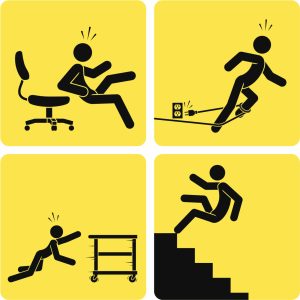 Workers compensation is a type of insurance that helps employees recover from workplace injuries or illnesses developed through one’s work. Each state has a different set of laws for its workers compensation program, with benefits covering medical expenses, prescription medication, death benefits, lost wages and rehabilitation services. In most states, a company with even one paid employee (even if that employee is temporary) must carry workers compensation insurance.
Workers compensation is a type of insurance that helps employees recover from workplace injuries or illnesses developed through one’s work. Each state has a different set of laws for its workers compensation program, with benefits covering medical expenses, prescription medication, death benefits, lost wages and rehabilitation services. In most states, a company with even one paid employee (even if that employee is temporary) must carry workers compensation insurance.
Almost none of us think we’ll be injured on the job, and some workplaces are so rigid about safety rules and measures that employees can feel annoyed with all the regulations. But unfortunately, accidents do happen. In fact, the Bureau of Labor Statistics reports that more than 1.1 million injuries took place in American workplaces in 2011, with an average recuperation period of eight days.
We’ve compiled the 10 most common workers compensation injuries, along with the types of jobs that file the most claims every year.
1) Overexertion
Overexertion can occur when someone lifts, pulls, pushes or throws something, causing an injury. This may involve a pulled muscle, or a sprained joint that gets jammed beyond its typical range of motion. Such injuries are most commonly reported in factory jobs, construction jobs, or positions that involve intense physical labor. Such injuries are also common among police officers. According to a study published by the Department of Labor this is the #1 more common workplace injury.
2) Slips and Falls
Many of the slip, trip, and fall injuries happen when workers lose their footing on wet floors around the workplace. These cases can also be related to slipping and falling on snowy walkways. Security workers, groundskeepers, and store clerks often fall victim to wet floors, particularly after business hours when the workplace has closed to the public and has a freshly mopped floor – or when a groundskeeper is walking around a building.
3) Fall to Lower Level
Falls from one level to a lower level often happen workers slip off a ladder, a roof, or fall down a flight of stairs. Roofers slipping from a roof, construction workers falling from a multi-level workspace, or even white-collar professionals (like teachers or nurses) tripping down a staircase are all instances of falling to lower levels.
4) Bodily Reaction
A bodily reaction injury can happen when a person trips or slips and actually avoids falling, but still sustains an injury like a twisted or sprained ankle. Such a workplace injury can happen anywhere, at any time. Some of the most common occupations to experience this injury are police officers and nurses.
5) Struck by Object
Object-injury occurs most frequently when something falls from a shelf, or an item is dropped by a co-worker onto a lower level. Restaurant & retail workers spend a lot of time grabbing items off of high shelves, and are at high risk of being struck by something.
6) Struck Against an Object
This injury occurs when a worker falls into something, or gets physically forced into a hard space like a bookshelf, barricade, or other stationary object. Both office workers and factory workers can easily become injured as a result of falling into something.
7) Highway Incident
One of the top causes of injury – particularly serious injury – occurs from accidents while driving. Truck drivers, not surprisingly, are at especially high risk, but these injuries also frequently happen to traveling business representatives and police officers.
8) Machinery Accidents
Machinery accidents are most commonly reported when large, heavy industrial machinery injures a worker by crushing or mutilating a body part. These injuries are commonplace in factories and on construction sites, where they have huge medical costs and serious physical consequences. Many states have passed laws mandating training for employees before they can operate equipment, or do any maintenance for machinery. Keeping employees knowledgeable on equipment, and keeping equipment maintained for worker safety, are two important ways to prevent accidents and protect employees from injury.
9) Repetitive Motion
A repetitive injury is difficult to pin-point, making it even harder to prove. These injuries arise from doing the same motions over and over again. Examples of repetitive motion injuries can result from sitting, lifting boxes, working on an assembly line, and even small gestures like using a mouse. From a medical standpoint, common repetitive motion injuries involve tendonitis, carpal tunnel, and bursitis.
10) Workplace violence
According to reports from the Bureau of Labor Statistics, “375 workers were killed in shootings while on the job in 2012. Robbers were the assailants in 33% of the workplace homicides involving shootings in 2012, while coworkers accounted for 13%. There were two incidents in 2012 where at least 5 people were killed in workplace shootings; a total of 12 workers died in these two incidents. From 1992 to 2012, 140 government workers were shot and killed by colleague while at work. Nobody thinks they’ll actually fall victim to violence in the workplace … until it happens.
There are four job positions that make up a full 20% of this type of violent injury: Police/Security officers, Nursing Aides/Orderlies/Attendants, Janitors/Cleaners, and Tractor-Trailer/Heavy Truck drivers. Due to the high physical activity required by this work, along with the exposure to dangerous situations, these jobs show some of the highest rates of workplace injury.




